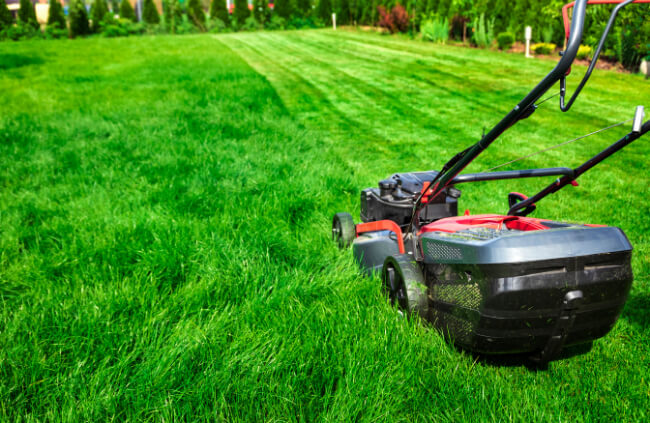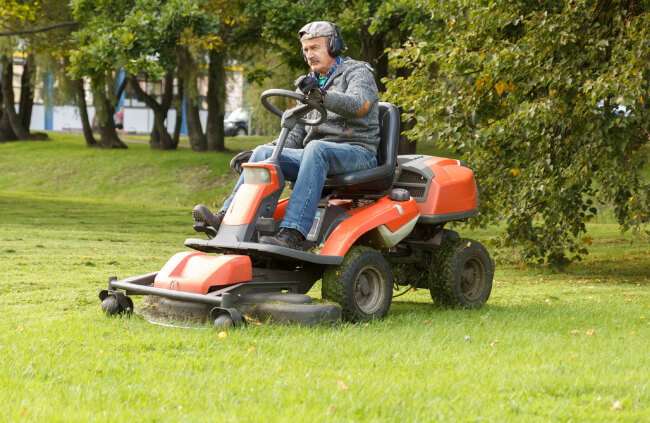Fashions for lawn care come and go, but a well-kept green carpet will always provide the tidy focal point your garden needs. Understanding how and when to mow a lawn depends on exactly what you want out of it though.
In this guide to mowing the lawn, and mowing them well, I’m going to share some tips for every outcome, whether you want those turn-of-the-century rolled stripes, or if you’re simply trying to tidy up the edges of a meadow patch.
More...
Benefits of Mowing the Lawn

Nearly all species of lawn grass will grow to 30 cm tall in the wild. When that happens, they become sparse at the base, and long dead grass forms a thick thatch that can rot and cause disease.
Even if you don't want a tightly clipped lawn, annually tidying up by removing that thatch and encouraging regrowth reduces potential fungal problems in lawns.
Outside of wildlife gardening though, cutting your lawn has obvious benefits to garden tidiness. And the more you do it, the lusher your lawn will be.
We’re not talking about putting greens here, but if you can keep your lawn cut to about 3-4 cm, light and moisture will get down to the base more efficiently, creating a richer green tone across its whole surface.
What are the Tools for Lawn Mowing?
It might sound like an obvious question, and the answer is quite clearly ‘a lawnmower’, but what type of lawnmower? Well, that really depends on the size of the lawn.
Electric vs Petrol Lawn Mowers
Electric lawn mowers have come on leaps and bounds, and for 99% of gardeners will produce equally good results to a petrol mower.
On smaller lawns, corded electric mowers make a lot of sense, but on larger lawns, cordless mowers are a necessity for the freedom of movement.
The bigger the lawn gets, the more battery life you’ll need, and beyond that, you’re looking at petrol lawn mowers simply to offer the run time needed for big lawns.
See our reviews of different types of electric mowers below:

Push Mowers vs Ride On Mowers
On really big lawns (anything getting close to an acre or more, electric or petrol ride on mowers are not just helpful, but they are basically essential. Then there’s the question of gradient.
Any gradient above about 15 degrees will require a more powerful self-propelled mower to get up and down hills safely. There’s a lot to choose from, so check out our guides to each type of mower linked above to see exactly what you need, and why.
Note: If you’re really looking for low carbon alternatives, traditional scythes and lawn scissors are great for wildlife gardens. They’re slow, but if you keep them sharp they allow you to safely cut your longer lawns back without harming nesting wildlife.
Whipper Snippers and Edgers for Finishing Off Lawns
As well as general cutting, lawn borders where grass connects to paths and flower beds need regular care. Running round once or twice a year with a garden edger will keep them truly neat and tidy, but the more often you use your whipper snipper, the neater they’ll stay.
For more information on both, check out our guide to using whipper snippers more effectively, and this buyer’s guide to garden edgers.
When to Mow Your Lawn
When to mow your lawn is probably more important than how to mow your lawn, so let’s just break this down. For example, my neighbour will mow his lawn religiously every week as soon as he thinks winter’s over, and until it comes back round. His lawn is basically a sand pit in summer because of it.
Different seasons need different routines, but the basic rule is that any lawn will always look its healthiest when grass blades are about 8 cm long. It’s a simple rule, and partly a bit of visual trickery, because it creates a thicker and more even lawn, rather than actively greening it up – that’s a job for lawn fertiliser spreaders, not your lawn mower!

Mowing the lawn in spring
Spring is the hardest time to work out a mowing schedule, because rainfall and sunlight can vary so much. If you’ve been mowing in winter (not necessary in much of the country) keep to the same schedule, and slowly work towards a fortnightly mow in summer.
Lawn mowing in summer
Right through summer, your lawn will be racing away. If you go on holiday for more than a week, it can quickly become an untameable jungle if the rain is on its side.
To keep a neat tightly clipped lawn, aim to mow once a fortnight. If it’s been raining a lot, in conjunction with a good feed in spring, and plenty of sun, you might need to mow weekly, but respond to the grass. Mow when it gets to about 8-9 cm long, and cut back to 5-6 cm.
How often to mow the lawn in autumn
Most of autumn should see you sticking to mowing once every two weeks. It’s still warm and the rain’s a little more regular, so your grass is likely loving life. As temperatures start to drop, you’ll notice your grass responding by slowing down. Drop down to about one mow a month in early winter.
Mowing the lawn in winter
Depending on where you are in Australia, there’s often no need to mow in winter at all. Shorter days slow down grass growth, but in some parts of the country, stick to your autumn monthly schedule.
What is the best time of day to mow your lawn?
Provided it’s dry, you can cut your grass at any time of day, but morning cutting is better for grass health. This isn’t just a gardening myth, it’s because each blade takes about eight hours to heal over its cuts.
By the evening, humidity level rises, and fungal spores can grab onto cut grass blades, and thrive through a warm summer night. Cutting in the morning gives enough time for grass to heal over, and reduces the chances of yellow tips.
When should you NOT mow your lawn?
Some lawn mowers recently have started advertising themselves as wet weather lawn mowers. It’s a classic example of doing something because you can, not because you should.
Never cut a lawn during or after rain. The roots have less of a hold on the soil and it can rip your grass, rather than cut it. On old mowers, it will also lead to clogs as the wet grass fails to pass through into the clipping bag.
How to Mow the Lawn

Things to Consider When Mowing the Lawn
Lawn Mower Blade Height
There are some clear contradictions in how we gardeners talk about mowing lawns, not least, when we discuss what height to cut to. I’m a firm believer in a longer lawn, but if you want neat, tightly clipped lawns there are some things you should know.
Firstly, those tight clipped lawns are more likely to let weeds grow. Long lawns act as a natural mulch, and offer greater competition to weeds, preventing germination.
Longer lawns look greener than tightly clipped lawns if they are equally fed. I don’t necessarily mean a meadow lawn either, just the small difference between a 3 cm clip and a 6 cm clip makes a huge difference to how lush your grass will look.
Mowing Directions
However you cut your lawn, it’s important to change direction. If you mow every week, change direction every week.
- First week mow from top to bottom.
- Second week, mow right to left.
- Third week, mow in diagonal from top right to bottom left.
- Fourth week, mow from top left to bottom right.
This reduces the damage of tire tracks compressing in the same direction every week, and it means you’ll catch those stray blades that got missed last time.
Mowing the lawn for weed control
The longer you leave your lawn, the fewer weeds you’ll have. It’s a contradiction, but it’s true. Unless you can to the height of a golf putting green, weeds will grow in shorter lawns, and their leaves tend to spread out flat, suppressing grass as they go.
Even if you leave the grass long for the late spring, while weeds are trying to germinate, and then mow in early summer, it will make a big difference to how many weeds you have, as well as offering grass pollen to insects for a few extra weeks.
Mowing the lawn with wildlife in mind
Grass doesn’t have to be mowed regularly to look good, but even long grass looks good with a neat border to it.
If you do decide to grow your own meadow or wildlife patch, cutting neat lines and paths through it as often as possible will keep it looking intentional. The impact of that simple mow also adds a beautiful undulating depth to gardens, as you see shadows between sections of long grass.
If you’re going to go for this, it will need to be mown hard at least once a year, if not twice. Cutting right back to the soil will allow wildlife seeds to make contact with the soil in early autumn, ready to establish for next spring. Cutting again in spring will give them enough light to burst into action and keep up with the taller grass.
How to Mow a New Lawn
Newly laid lawns are tricky to mow. My usual advice is to leave it for at least a month before mowing, and watering regularly while it establishes. Grass will begin to root into loose topsoil as seeds or turf within about a week, but the longer you leave it, the better established those roots will be.
Even walking on newly laid turf or grass seed can break the process, but it is slightly different for each.

When to mow newly laid turf
Turf will continue growing as long as you water it, and that can easily trick you into thinking it’s time to cut it. However, it’s not about top growth, it’s about rot growth.
Tug your turf around the edge. If it lifts up at all from the soil, keep watering and let it grow. Once it’s firmly attached to the soil below, you can mow to your heart's content.
If it grows slightly too long, that’s far better than mowing too soon, and ending up with dead patches where it fails to root completely.
When to mow a newly seeded lawn
A completely new patch of grass, sown from seed, should be at least 8 cm long before you cut it. It will look sparse for a while, and likely not form a complete thatch until the second year, but by the time each blade reaches 8 cm, it has rooted well enough to recover from being cut, and from being stood on.
Choosing the Best Grass Types for a Perfect Lawn
As well as mowing for a tidy finish, one big consideration is always choosing the right grass seed. Different grass seeds grow at different rates, and some can cope better on drier or wetter soils than others.
For more information on choosing the best type of turf, check out our guide to grass types in Australia.
Frequently Asked Questions About Mowing the Lawn
Should you edge or mow your lawn first?
Always mow your lawn before edging it. Mowing your lawn first means you know exactly how short to cut your grass at the edge, whether it’s with a whipper snipper or an edger.
Is it better to mow fast or slow?
The slower you mow, the more thorough you’ll be, and the more even your lawn will look. Mowing faster generally results in missing taller blades of grass, and walking at a slower pace with your mower means it will pick up and catch as much grass as possible.
Can you mow backwards?
Very few mowers are capable of mowing backwards and producing good results. Some mowers (self-propelled types) can actually be broken by mowing backwards too.
Should I leave grass clippings on my lawn?
If you cut your grass every one or two weeks in summer, it’s not just ok to leave clipping on the lawn, it’s good for it. Grass clippings are a good nitrogen source, and help to put the nutrients they’ve taken from the soil back in.
Why is my lawn yellow after mowing it?
If your grass is turning yellow after it's mowed, it’s usually due to dry conditions where the shock of the cut, coupled with a lack of moisture in the soil leads to cuts that dry out, rather than heal or fill with chlorophyll.
Can you cut grass every day?
It’s nearly never advisable to cut grass every day. There are some specialist grasses which can cope with being cut once a day once they are properly established and well fed on good soil, but there is very little need to cut any lawn more than once a week at most.
Wrapping Up Our Guide to Mowing the Lawn
Regardless of your personal preferences for lawn design, mowing is an essential part of lawn care. Even for me, a self-confessed chaos lover, who deliberately leaves sections of my garden to grow wild, I wouldn’t be without a few patches of perfectly preened turf.
The calm and serene open space offered by a lush green lawn is inimitable in its beauty, and will likely always be part of any practical and beautiful garden design.
As the traditional knowledge of how to mow a lawn is replaced by modern technology, it’s worth considering how you can keep a bit of tradition alive in your own garden.
Published on August 19, 2023 by Gary Clarke
Last Updated on December 21, 2023




